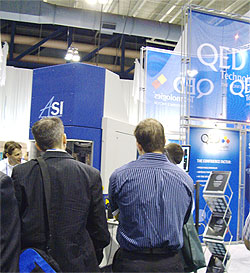
A Giant Leap for Metrology
ROCHESTER, NY, May 13, 2009 -- The manufacturing cycle for aspheric optics has four general stages: grinding, then pre-polish, metrology, and finally magnetorheological finishing (MRF).
There have been improvements in the grinding, pre-polish and MRF stages, but fewer developments in metrology – until now.
QED Technologies of Rochester, NY, has offered steady advances in metrology over the past five years, according to Marc Tricard, director of business development at QED.
In 2004 came SSI -- subaperture stitching interferometry -- which is capable of measuring flat and spherical optics. Then came SSIa, which can measure flats, spheres and "mild" aspheres of 100 waves or less, in 2006. SSIa+ arrived in 2008, raising the waves measured to 200.

A crowd gathers to watch a demonstration of QED Technologies' ASI (aspheric stitching interferometer) at Optifab 2009 in Rochester, NY. Photo by Laura S. Marshall.
But the company's newest development, called ASI (aspheric stitching interferometer) is a giant leap forward, and likely to revolutionize the industry, said Tricard at the Optifab 2009 trade show. The ASI, based on QED's subaperture stitching technology, is capable of measuring steep aspheres with as much as 1000 waves (more than 600 microns) of departure from the best fit sphere. Even better, the ASI does not require the use of the dedicated null lenses or computer-generated holograms needed by traditional methods; this significantly reduces cost and lead time for asphere production.
The ASI is based on QED's subaperture stitching technology and is complemented by its patent-pending variable optical null technology. The variable optical null is a programmable opto-mechanical subsystem that generates a wavefront closely matching the surface of the asphere subaperture being measured. The system takes high-resolution subaperture measurements over the entire optical surface, and the results are stitched together to form a full aperture map of the asphere being tested.
"The release of the ASI opens new doors for optical systems designers and optics manufacturers alike," said Tricard. "We know that incorporating aspheres into optical system design is very efficient. In addition to increased optical performance, the use of aspheres generally results in fewer optical elements, less weight and reduced size.
"Designers can now incorporate steep, complex aspheres into optical systems designs with the knowledge that with ASI, manufacturers have access to the right tools to manufacture and measure them accurately in a rapid and cost effective manner."
He said he expects the ASI to change the industry. It may take a few years to catch on fully, he said, comparing it to single-point diamond turning, which is now widely used for aspheric optics production.
QED Technologies, a wholly owned subsidiary of Cabot Microelectronics Corporation, offers finishing and metrology solutions designed to meet the needs of advanced optics manufacturers by increasing production speed and yield while decreasing costs.
Laura S. Marshall
[email protected]
/Buyers_Guide/QED_Technologies_Inc/c12349